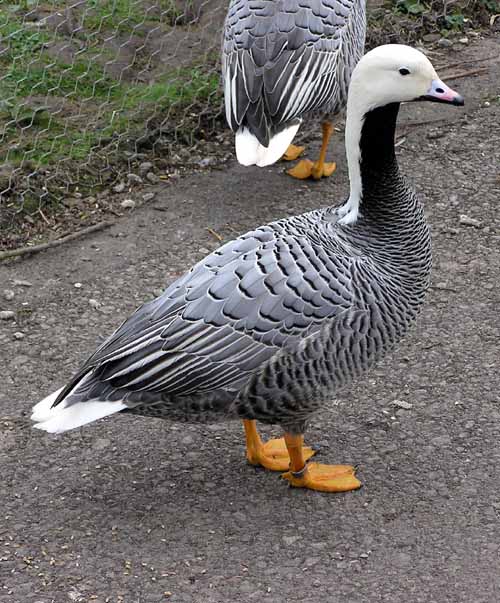|
| Query: Emperor goose | Result: 1st of 47 | |
Emperor Goose (Chen canagica) - Wiki
| Subject: | Emperor Goose (Chen canagica) - Wiki
| |

| Resolution: 500x603
File Size: 89951 Bytes
Date: 2004:03:29 14:57:06
Camera: C750UZ (OLYMPUS CORPORATION)
F number: f/3.2
Exposure: 10/5000 sec
Focal Length: 208/10
Upload Date: 2008:01:07 10:01:17
|
Emperor Goose
From Wikipedia, the free encyclopedia
Order: Anseriformes
Family: Anatidae
Synonyms: Anser canagicus, Philacte canagica
[Photo] Emperor Goose (Chen canagica) at Slimbridge Wildfowl and Wetlands Centre, Gloucestershire, England. Taken by Adrian Pingstone (http://en.wikipedia.org/wiki/User:Arpingstone) in March 2004 and released to the public domain.
The Emperor Goose (Chen canagica) is a species of goose. It breeds around the Bering Sea, mostly in Alaska, USA, but also in Kamchatka, Russia. It is migratory, wintering mainly in the Aleutian Islands.
The American ornithologist David Sibley places this species and the North American "white" geese in the genus Chen, rather than the more traditional "grey" goose genus Anser.
The Emperor Goose has a stout grey body, subtly barred with fine barring, and a white head and hindneck, often stained orange from iron-rich waters. Unlike the blue morph Snow Goose, the white does not extend onto the front of the neck. The sexes are similar, but immatures have the head the same colour as the body.
This species is much less gregarious than most geese, usually occurring in family groups. It breeds on coastal tundra, laying 3-7 eggs in a ground nest.
Breeding birds moult near the breeding colonies, but non-breeders move to St Lawrence Island to moult prior to the main migration to the rocky coastines of the wintering grounds.
The food of emperor goose is typically composed of shoreline grasses and other coastal plants.
http://en.wikipedia.org/wiki/Emperor_Goose
| The text in this page is based on the copyrighted Wikipedia article shown in above URL. It is used under the GNU Free Documentation License. You may redistribute it, verbatim or modified, providing that you comply with the terms of the GFDL. |
|
Comments |
|---|
| | Guest |
|
Emperor Goose
(Chen canagica)
The Emperor Goose is a small stocky goose found in Alaska and nearby parts of Russia. Breeding and wintering on coastal beaches in the area, the population of this blue-gray goose declined drastically in the 1970's and 80's. The causes of this decline are not well understood.
Identification
A small blue-gray goose with a round body and white head. Although some dark forms of Snow Goose and Ross's Goose can appear similar at first glance, the white tail set off from this species' dark tail coverts and body is unique.
Distribution and Population Trends
Restricted to the coasts of Alaska and nearby Russia. The Emperor Goose breeds primarily in western Alaska, and parts of Russia flanking the Bering Strait. In winter, the majority of the population moves to the Aleutian Islands, where they seek out ice-free beaches though rarely individuals have been found along the Pacific Coast south to California.
The Emperor Goose population declined from an estimated 139,000 in 1964 to 42,000 in 1986. Aerial counts were not carried out continuously during this time period, but have been since 1981. Currently, the population seems to be on the rise in Alaska. Little is known about the cause of this decline, or when after 1964 it may have begun.
Ecology
Nest site selection is made by the female Emperor Goose and usually occurs immediately prior to egg laying. Nests are lined with dead vegetation from the immediate area, and down is added after a number of eggs have been laid. The male Emperor Goose stands nearby during nest building and egg laying. Males may chase other males away from the area of the nest site. Males will also confront predators, or try to distract them and lead them away from the nest site. The female is sole incubator of the eggs. Young are covered in down when they emerge from the egg, and leave the nest soon after hatching.
The Emperor Goose feeds primarily on plant matter during the breeding stage. In winter, this species feeds primarily on invertebrates and marine vegetation found in the intertidal zone.
Threats
Due to its low population size, and restricted range, the Emperor Goose is especially vulnerable to local catastrophic events, such as oil spills. In winter, the majority of the global population of this species can be found in the Aleutian Islands. Large percentages of the population also concentrate in staging areas along the Alaskan Peninsula during migration.
Subsistence hunting in the spring and summer may have contributed to their decline. In spring, adult birds in flight are reported to circle closely around humans walking on the tundra.
Conservation
Management guidelines have been established for the species, including closure of all hunting when the three year running average for the population falls below 60,000 birds. Hunting is not allowed again until the population is estimated at 80,000 or more. |
^o^
Animal Pictures Archive for smart phones
^o^
|
|
|

